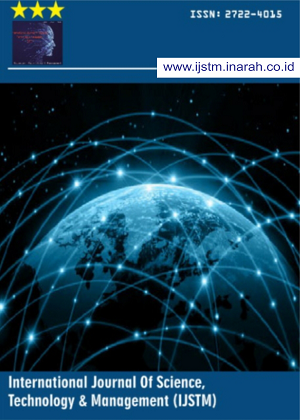Description Of Head Lice (Pediculus capitis) Infection Of Primary School Age Children In Elementary School Negeri 40, Salero District, Central Ternate District, Ternate City, 2022
Abstract
Head lice are the cause of the ectoparasitic disease pediculosis capitis. Both adults and children in school can have head lice. A public elementary school (SDN) 40 in Salero Village, Ternate City is utilized to illustrate how Pediculus capitis might spread. The purpose of this study is to characterize head lice infections caused by Pediculosis capitis in elementary school-aged children and to identify the risk factors that contribute to the spread of this infestation. This study uses a descriptive, analytical, correlative research design. The children in grades 4, 5, and 6 of SDN 40 comprised the study's population. The process of sampling involved tracking head lice infections according to factors such as age, gender, infection location, itching in the head, hair type, length, and frequency of hair washing r with Pediculus capitis infection (p-value = 0.001 and OR 0.102-0.570); long hair with Pediculus capitis infection (value = 0.000 and OR 101-0.569); hair washing interval with Pediculus capitis infection (p-value = 0.000 and OR 0.019-0.415) and use of combs together with Pediculus capitis infection (p-value = 0.001 and OR 00.141-0.789). Hair type did not have a significant relationship with Pediculus capitis infection with a p-value = 0.852 and OR 0.477-2.505.
Downloads
References
Elston, D.M. 2016, ‘Arthropods and Leeches’ in Goldman-Cecil Medicine, 25thedn, eds. G. Lee & S. Andrew,
Elsevier, Inc., United States of America, pp. 2175
Massie, M. A., Wahongan, G. J. P., & Pijoh, V. (2020). Prevalence of Pediculushumanus capitis infestation in
elementary school children in East Langowan District Jurnal Biomedik, 12(1),24–30.
Saghafipour, A., Nejati, J., Zahraei-Ramazani, A., Vatandoost, H., Mozaffari, E., & Rezaei, F.(2017). Prevalence
and risk factors associated with head louse (Pediculus capitis) in Central Iran. International Journal of
Pediatrics, 5(7), 5245–5254. https://doi.org/10.22038/ijp.2017.23413.1967
Pringgayuda, F., Putri, G. A., & Yulianto, A. (2021). Poor Personal Hygiene Increases the Incidence of
Pediculosis Capitis in Islamic Boarding School Students. Jurnal Keperawatan Muhammadiyah, 6(1), 54–59.
International Journal of Science, Technology & Management ISSN: 2722 - 4015
Kartini, S., Hendrika, Y., & Wahyudiani, R. (2021). Test of the Effectiveness of Ethanol Extract of Jatropha
Curcas L. Leaves on Mortality of Head Lice (Pediculus humanus capitis). Journal of Pharmacy and Science,
(1), 35-40.
Rahmita, R., Arifin, S., & Hayatie, L. (2019). Relationship between Residential Density and Room Humidity
with the Incidence of Pediculosis capitis. Homeostasis, 2(1), 155–160.
Wungouw, H., Memah, V., Salaki, C., Tarore, D., Ottay, R., Doda, V. D., Rumampuk, I., & Rumampuk, H.
(2020). Prevalence of Pediculosis Capitis and Associated Factors among Primary School Children at Kawiley
Village North Sulawesi, Indonesia. Scholars Journal of Applied Medical Sciences, 8(11), 2478–2482.
ttps://doi.org/10.36347/sjams.2020. v08i11.008.282-291
Widniyah, A. Z. (2019). Behavior Model for Preventing Pediculus Humanis Capitis in Female Students at
Islamic Boarding Schools. Jurnal Keperawatan, 16–20.
Khasanah N.A.H, Yuniati N.I, Husen F, , Rudatiningtyas U.F, 2022. Personal Hygiene Risk Factor Analysis of
Pediculosis capitis in Miftahul Huda Islamic Boarding School Students . Journal of Holistics and Health
Sciences, 4,( 2). 2022
Noersyamsidar, Suprihartini, 2022, Description of Pediculus humanus capitis infection in children at the
Dharma Child Protection Social UPTD Beach. Borneo Journal of Science and Mathematics Education, Vol 2
N. 3,. E-ISSN: 2775-6556, P-ISSN: 2775-6556
Lukman, Armiyanti Y, Agustina D, 2018. The Correlation of Risk Factors to the incidence of Pediculosis capitis
on Students in Pondok Pesantren Miftahul Ulum, Jember. Journal of Agromedicine and Medical
Sciences.4(2):102-109
] Hermawan R.A, Shofia M, Viorentin Natalia Moi V.M, 2023. Corelation of Rik Factors With Infestation
Pediculus humanus capitis in Elmtary School of Bandar Lor 1 Kediri City. Bio Sains: Jurnal Ilmiah Biologi,
(2). https://uia.e-journal.id/biosains/about
Nurdiani, C. U. (2020). Factors Influencing Pediculosis capitis in Children Aged 6-12 Years at the Sirojan
Mustaqim Islamic Boarding School and Residents of RW 03, Pondok Ranggon Village, Cipayung District, East
Jakarta. Anakes: Jurnal Ilmiah Analis Kesehatan, 6(1), 39–48
Maryanti, E., & Lestari, E. (2020). Health Education in the Context of a Pediculosis Capitis Free Orphanage in
Siak Hulu District, Kampar Regency, Riau. Journal of Empowerment, 3(2), 97–103.
Damayanti, S. (2018). The Relationship between Personal Hygiene and the Incidence of Pediculosis Capitis in
Kloposawit State Elementary School Students, Turi, Sleman, Yogyakarta. Jurnal Kesehatan Masyarakat, 11(1),
–959.
Suweta, N. P. T. B., Swastika, I. K., & Sudarmaja, I. M. (2021). Prevalence of Pediculosis Capitis and Risk
Factors for Infestation in Children at Elementary School No. 6 Darmasaba, Abiansemal District, Badung
Regency. Jurnal Medika Udayana, 10(6), 54–60.
Cahyarini, I. G. A. A. C., Swastika, I. K., & Sudarmaja, I. M. (2021). Prevalence and Description of Risk Factors
for Pediculosis Capitis in Children at State Elementary School 11 Dauh Puri, Bali Province. Jurnal Medika
Udayana, 10(10), 21–27.
Copyright (c) 2024 International Journal of Science, Technology & Management

This work is licensed under a Creative Commons Attribution-ShareAlike 4.0 International License.
































